Cornering in a car isn’t a specific subject that is often taught whilst learning to drive by your instructor.
It’s often a ‘hit and miss’ affair (no pun intended) until the learner naturally gets the hang of it. Reason being is that there’s no specific technique that can be taught until you get into advanced driving, where subjects such as limit point analysis techniques help to define a driver.
In the meantime, it’s typically left to the learner driver along with verbal remedial guidance from a driving instructor to naturally find the ability to take corners. That’s not to say that there’s not plenty of tips on offer for the learner.
This tutorial offers advice for the novice driver to drive through bends and corners with a clearer understanding.
Cornering in a car
Although cornering in a car may require as little as a turn of the steering wheel, there is a little more to it than that. For a complete novice, or a learner with little experience, it’s often difficult to establish where the kerb on the left side of the car is in relation to the car. This is where reference points or markers are beneficial. It’s beneficial to use reference markers for many aspects of the learning to drive procedure.
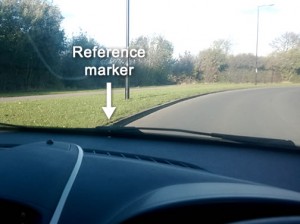
As can be seen on the image to the left, turning a right-hand corner, you can see where the kerb enters the car at the top of the dashboard. A reference marker can be placed in this area (a small sticker will do, or simply remember where the kerb comes into the car) to establish the correct distance the car is from the kerb whilst cornering.
If the kerb goes over to the right too much past the reference marker, you’re getting too close to the kerb, too far left and you’re too far away. This reference marker is also ideal to establish an ideal distance from the kerb whilst traveling in a straight line also.
To establish the correct reference markers, ask your instructor when you are the correct distance from the kerb and either remember where the kerb comes into the dashboard, or stop the car (in a safe area on a quiet road) and place a small sticker where the kerb comes in. This reference marker should be used as an estimate only and used temporarily until you feel proficient enough to establish the correct distance from the kerb without their use.
Locating bends in the road
Upon gaining proficiency with steering round corners, you will encounter many road bends whilst learning to drive. To safely drive through a corner, you first need to locate it. Signs are often placed on bends, especially on out-of-town roads and rural roads. Many motorists fall off the road each year on corners. Reasons attributed to this are a lack of realisation of a bend ahead, entering the bend too fast and losing traction. Learn to acknowledge each and every road sign and road marking you pass. Most are there to help you.
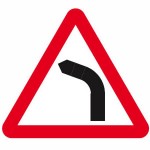
(Right corner if symbol reversed)
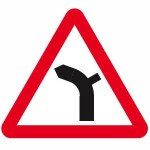
(Junction on right bend
if symbol reversed)
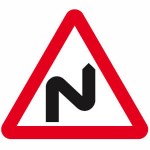
Bend first to right, first to left if symbol reversed)
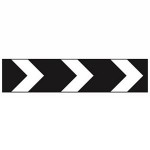
(Markings may be
reversed)
At particularly dangerous areas where bends may be very sharp, road signs may be accompanied with road markings telling you to slow down. Be highly cautious of bends with junctions (see sign above). Vehicles may be entering or exiting the junction. Not all bends in the road will have a warning sign before them. Such bends are particularly hazardous on rural country roads.
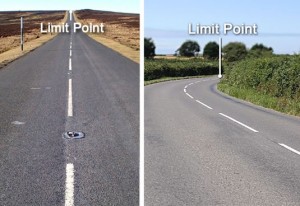
To help understand when a bend in the road is approaching, think of a long straight road. At the very tip, in the distance the two sides of the road appear to meet each other. This is called the limit point – the visual limit of the road ahead.
On a continuous straight road, you will never reach this limit point. As a bend approaches however, this limit point will gradually get closer. The faster it approaches, the more you will need to slow down before taking it. See Limit point analysis for more details.
Before taking the corner
Now that you’ve located the corner up ahead:
- Check your mirrors to ensure a vehicle (if any) behind you is not following excessively closely. If they are, you may need to slow down sooner to provide them with more time to react to the bend up ahead.
- Assess your speed and adjust accordingly based on how fast the bend is approaching and if any vehicles are following. Ease off the accelerator earlier rather than using the brakes harshly later. This is safer and is also kinder to the car. When braking, use progressive braking as this technique provides a smooth transition in speed and is safe for other road users. Change down gear if necessary as this may provide better control of the car.
- Check your road position by ensuring you keep to the centre of your lane. Avoid creeping too close to the opposite carriageway as other vehicles may be taking the corner wide, especially if the vehicle is large. Avoid cutting the corner at all costs.
Braking whilst cornering
Always try to gain the appropriate speed for the corner before entering it. Tyres need to deal with a lot of forces. In a straight line motion, a car is balanced and stable, as you enter a bend, the tyres need to deal with forward motion, plus centrifugal force. They’re making you go forward, but also trying to prevent you from skidding off the road due to steering round the corner. That’s a lot to deal with but if you now add braking into this, you really begin to upset the balance of the car. Almost all weight is now distributed to just the front tyres.
Unless you enter the corner at a ridiculously high speed, braking whilst cornering may not be too much of an issue whilst driving on a flat, stable and dry road. Try braking whilst cornering on wet or icy roads however and all of a sudden your car becomes an out-of-control metal missile. Always try to avoid braking, especially harshly on a bend. Along with being far safer, it’s also a lot kinder to your tyres, giving them a longer lifespan.
Exiting the bend
As the bend begins to recede and open up you can gently begin to accelerate once again. Take another look in your rear view mirrors on the corner exit as this is a common place where motorists may attempt to overtake.
Cornering on wet or icy roads
Your car is far more likely to lose traction with the road surface if it is wet, and even more so if icy. Always take weather conditions into account whilst driving. Harsh corners will likely need to be taken at a much reduced speed in bad weather and remember to avoid heavy braking whilst cornering.
Cornering in a car tips
The main objectives whilst taking a corner in a car are:
- Enter a corner at a speed you intend on taking it
This is to avoid harsh braking whilst cornering which can result in your car losing control. Harsh braking put heavy load and forces on the front tyres making the vehicle unstable. - Lane discipline
Lane discipline is crucial whilst entering the corner and whilst traveling around it. Never cut a corner as you never know what might be coming the other way. - Stopping distances
Always consider your stopping distance and ensure you are able to safely stop within the distance you can see ahead. A basic understanding of limit point analysis may help to understand. - Weather and road conditions
Always consider your speed before entering a corner, not only due to the severity of the corner, but whether the road is wet, icy and the condition of the road surface itself. Loose chippings and potholes impact the stability of a car whilst cornering.
Limit point analysis
Limit point analysis is usually regarded as an advanced driving technique. Although this technique may be a little advanced for a novice or learner driver to attempt, certain aspects of it can be used to help. Limit point analysis provides drivers with a safe stopping distance whilst taking corners. Along with this, it can also benefit a learner driver by providing an indication of a suitable speed at which to enter a corner- something which many learners struggle with.

it’s ”curb,” not “kerb”—helpful tips, though.
Hi Armand,
Glad you found the page helpful. Curb is US English and Kerb is UK English.
Thanks! Did not know that!!!!
Kerb is correct
Do i need to put 4th gear from 5th while I was coming to 2nd gear in driving test. And how to slow down gradually.
Hi Pragna,
During the driving test and in modern cars, there’s no need to use the gears to slow the vehicle down, you use the brakes. This allows you to keep both of your hands on the wheel more of the time. So if you were slowing down for a bend, you would use the brake to slow to a suitable speed and then from 5th gear, put it into 2nd.
To slow down gradually, use engine braking when possible. This requires that you look well ahead and plan in advance. It also reduces wear on the brakes. When slowing down gradually (unlike a corner above) you can change down gear.
In reply to Armand.
Armand,
In British English, ‘curb’ is a verb & always refers to a limit or restraint. The word ‘kerb’ is always a noun and refers to the raised edge of a pavement or path. For example, I nearly tripped on the kerb while crossing the road. This spelling is standard in British English
Kerb & Curb.
US – Use Curb and Kerb as same thing., same word, same pronunciation – Bless them but here in UK – Engish – you ‘Curb’ spending or craving You park next to a Kerb
Andy
I really needed this. thanks
Hoping these tips will help me when I next drive, had my first lesson today and decided I really don’t like going around corners! My dad told me to find a reference point and use that to help me but I had no idea what that meant and often went to far to the right when turning. Didn’t help that there were no lines in the road either
Hi Beth,
If you have any questions about learning to drive or the driving test, let us know. Always happy to help.